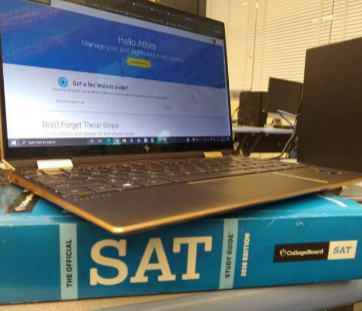College Board’s attempts to revamp SAT fall flat

The College Board has announced, starting Spring 2024, the SAT will be online and shortened.
May 30, 2022
Every year, thousands of students spend weeks preparing for three hours of testing for an exam that could make or break their future education and success. Since its creation in 1926, the SAT has continually failed to be an accurate measure of college readiness despite various revamps it has gone through, attempting to adapt to the world’s increasing modernity.
On Jan. 25, College Board announced that they will be changing the format of this historically controversial test for the third time in 20 years – making it entirely digital and shrinking the time frame, by spring of 2024. Despite the College Board’s best efforts to endorse the new SAT, the fact of the matter remains that these changes do nothing to eliminate this pointless, biased hurdle in the college admissions process.
The new SAT is meant to be less stressful, more accessible, and more accurate in measuring “college readiness”— an arbitrary standard that gauges a student’s potential success in higher-level education. This includes the end of frustrating bubble sheets that lead to cramped hands and lost points because of innocent stray marks on a booklet. Junior Christina D’albora said, “I think it actually might be harder for the reading sections because you can only see so much at one time because the screen is so small, in comparison to having two sheets open at the same time. When I did my practice tests they were all online and it’s much harder to do it that way.”
Additionally, the SATs will implement “adaptive testing” for the first time. This means that, like the MAP-M and MAP-R tests, students will get questions based on their performance in previous answers. According to the College Board, this helps give students questions “appropriate to their performance level” in order to accurately assess students’ mastery of key skills.
Due to its controversial nature, the College Board has attempted to make the new test fairer in order to address common criticisms that it is an entirely classist and racially biased exam. It recognizes that there are many students that do not have access to the technology required to take the exam, and has pledged to loan out computers to those that might need them.
It has also expanded the range of information and resources that it presents to students in regards to their education options after high school, including information about two-year college programs and workforce or vocational training options. Despite these efforts, the test still faces much of the same bias as its former versions, preventing it from being a comprehensive measure of “college readiness.”
The most prominent issue with the very existence of a standardized test involves its inherent financial bias. The plethora of high-end, expensive SAT prep courses is not easily accessible for everyone. These courses are extremely time-consuming and expensive, making it difficult for students that work to support their families and low-income students to benefit from them.
The test has a major issue with racial bias as well. On average, Black and Hispanic students do significantly worse than white and Asian students, perpetuating the dangerous stereotype that minority students —especially those less affluent— are less qualified for college. In actuality, this gap reflects disparities in the availability of important resources rather than intelligence or capability to excel in higher education.
It is vital to understand that just because some people do not perform well on standardized tests, it does not inherently mean that they are not intelligent, college-ready or built for success. Not only are there various learning styles, but there are also a variety of ways to demonstrate intelligence that the SAT does not account for. Students that do not shine on standardized tests may very well excel in other areas, making it so that the use of the SAT to determine someone’s acceptance into college inhibits a holistic approach.
If the College Board wants to help students feel less stressed and make college seem like an achievable opportunity for a majority of the nation, the only real answer is to eliminate standardized testing as a whole. Junior Anya Tahi said, “I think for people that have taken it on paper before it might be less stressful for them, but it will still be extremely stressful for those that haven’t taken it yet because it is still the SAT.” As long as the test remains in existence as a part of the college admission process, students are going to still believe their scores can make or break their applications.
The College Board needs to acknowledge that changing the format of the SAT does not reduce the heavy burden it places on students or eliminate the amount of bias it perpetuates. The impact of the changes made will be small and varied, denying students an “easier” or “less stressful” experience. Regardless of its attempts, the SAT remains an unnecessary hurdle in the college admissions process that simply serves to derail the lives of students. Its lack of accuracy in indicating intelligence and capability continues to cause extreme doubt about its relevance.


